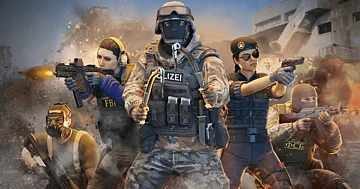Despite the advancement of gaming technology and the rise of newer titles, CS 1.6 has stood the test of time. It wasn’t built on elaborate features, cinematic visuals, or over-the-top mechanics. Its enduring popularity is due to the purity of its gameplay. A match in CS 1.6 is a lesson in precision, tactics, and split-second decision-making. You either outplay your opponent or you don’t—there is no room for luck or gimmicks. This same spirit of user-driven creativity and mechanics-focused design also lives on in other Valve-associated games and mods, one of the most notable being Garry’s Mod, a sandbox that allows players to build, script, and shape their own experiences. If you’re interested in exploring the other side of the Source engine’s potential, you can download GMod.
The Mod That Changed Everything
Counter-Strike didn’t begin as a full release. It started in 1999 as a community-made mod for Valve’s Half-Life. Created by Minh “Gooseman” Le and Jess Cliffe, the early Counter-Strike beta introduced revolutionary gameplay for the time: round-based team combat, money management, real-world weapons, and highly tactical engagements.
Unlike most shooters of the era, CS emphasized strategy and communication over speed and chaos. Two teams—Terrorists and Counter-Terrorists—would square off in objective-based matches where one team planted bombs or guarded hostages while the other team attempted to prevent those objectives. The gameplay loop was instantly addictive and became a new standard for competitive shooters.
Valve quickly took notice and acquired the rights, releasing an official version in 2000. Over the next few years, the game received multiple updates, culminating in Counter-Strike 1.6, which launched alongside Steam in 2003. With improvements to hitboxes, interface, and netcode, as well as easier access to servers through Steam’s matchmaking, CS 1.6 became the cornerstone of multiplayer gaming and one of the earliest showcases of what a digital platform could provide.
Gameplay Built for Competitors
What truly set CS 1.6 apart from other shooters—then and now—was its no-frills approach to competitive gameplay. Matches are structured around short, high-stakes rounds where players do not respawn until the next round begins. Every movement, every shot, every grenade must be carefully considered. There’s no random bullet spread or ability to regenerate health. Only skill, reflexes, strategy, and map knowledge matter.
Each round begins with players choosing from a selection of weapons based on their current in-game money. The economy system was one of the first of its kind, forcing teams to make decisions not just based on what they wanted, but what they could afford. Saving for a future round, executing a risky force-buy, or investing in utility instead of firepower are all decisions that still define competitive Counter-Strike today.
Recoil patterns and spray control are another major element of CS 1.6’s legacy. Learning how to properly use an AK-47 or an M4A1 required dozens of hours of practice, rewarding players who committed to mastering each weapon. Grenade usage—flashbangs, smokes, and HE grenades—offered additional tactical layers that could help control areas, execute ambushes, or deny vision.
CS 1.6’s brilliance lies in this blend of mechanical skill and team-based decision-making, which is why it remained the gold standard in FPS esports for nearly a decade.
Maps That Shaped a Generation
Counter-Strike 1.6’s map pool is a critical part of its success. Rather than being generic backdrops for combat, CS maps were meticulously crafted environments that demanded knowledge, strategy, and adaptability. These maps became legends in their own right, with players memorizing every angle, choke point, and grenade spot.
- de_dust2: Easily one of the most recognized maps in gaming history. Its simple layout and balanced design make it accessible for newcomers but endlessly deep for veterans.
- de_inferno: Known for its narrow alleyways and crucial mid control, Inferno rewards teamwork and precise grenade usage.
- de_nuke: A vertical, complex map with layered bombsites that require sound strategy and excellent communication.
- de_train: A sniper-friendly map with long sightlines and countless hiding spots.
- cs_office: One of the best hostage rescue maps, offering tight corridors and intense room-to-room combat.
These maps not only offered tactical diversity but also encouraged players to think like a team. Successful plays depended on timing, communication, and synergy.
CS 1.6 and the Esports Revolution
Before the rise of today’s multimillion-dollar esports industry, CS 1.6 was leading the way, setting standards for how competitive gaming should work. The game was a staple at early esports tournaments including CPL, ESWC, WCG, and countless regional events.
Players like HeatoN, SpawN, f0rest, NEO, Markeloff, and teams such as NiP, SK Gaming, and Fnatic became legends. These were not just top players—they were the pioneers of a professional scene that laid the groundwork for what we see in games like CS:GO and Valorant today.
The competitive format introduced in CS 1.6—team economy management, bombsite control, tactical rounds, map vetoes, and side picks—is still in use across almost every modern FPS tournament.
The Importance of Community and Modding
CS 1.6 was never just about the base game. Its longevity can be largely credited to the thriving community that surrounded it. Valve’s support for modding allowed fans to create an endless stream of content. Custom maps, weapon skins, plugins, and entirely new game modes flooded the scene.
Many players discovered the game not through its competitive mode, but through community servers offering fun alternatives like:
- Gun Game
- Zombie Mod
- Surf maps
- KZ climbing challenges
- Deathmatch arenas
This modding freedom is what made CS 1.6 feel fresh for years beyond its official updates. The same spirit lives on in sandbox titles like Garry’s Mod, where user-generated content is the heart of the game. Much like CS 1.6’s servers and mods, GMod thrives on creativity and community-driven development. You can download GMod to explore a completely different but equally influential experience.
Why CS 1.6 Still Matters Today
Even with the success of CS:GO and the release of CS2, Counter-Strike 1.6 continues to hold a special place in the gaming world—and not just for nostalgia. It remains a masterclass in FPS design:
- Lightweight and runs on nearly any machine
- No distractions—just core gameplay
- Excellent for aim training and mechanical mastery
- Maintains active community servers around the world
- Highly modifiable and endlessly replayable
CS 1.6 is not just a historic title; it is still alive thanks to passionate players and server hosts who keep it running strong. It is a symbol of what competitive gaming was—and still can be—when it’s built on fundamentals.
Final Thoughts
Counter-Strike 1.6 is not just a game; it’s a legacy. It’s the title that helped define competitive FPS gameplay, inspired the rise of global esports, and created one of the most loyal gaming communities in history. Its influence stretches far beyond its 2003 release, reaching into the design of modern shooters, the culture of online play, and the continued evolution of digital gaming platforms.
If you’ve never played it, you owe it to yourself to experience where it all began. If you’re a returning veteran, there’s no better time to jump back in. You can download CS 1.6 and relive the classic. And if you’re interested in a game that takes the spirit of community creativity even further, don’t miss the chance to download GMod as well.
Some games fade away. Others, like CS 1.6, become timeless.





























